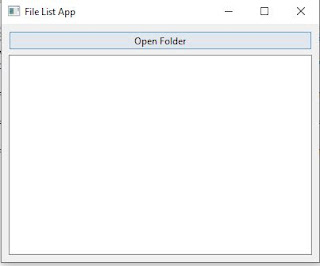In this tutorial, we'll explore a straightforward Python program that leverages the power of the os module and a graphical user interface library called PyQt6 to create a basic File List App. This application allows users to open a folder and view the list of files within it.
The Python Code
1 2 3 4 5 6 7 8 9 10 11 12 13 14 15 16 17 18 19 20 21 22 23 24 25 26 27 28 29 30 31 32 33 34 35 36 37 38 39 40 41 42 43 44 45 46 47 48 49 50 51 52 53 | import sys from PyQt6.QtWidgets import QApplication, QMainWindow, QVBoxLayout, QFileDialog, QListWidget, QPushButton, QWidget import os class FileListApp(QMainWindow): def __init__(self): super().__init__() self.initUI() def initUI(self): self.setWindowTitle('File List App') self.setGeometry(100, 100, 400, 300) # Create widgets self.list_widget = QListWidget(self) self.open_button = QPushButton('Open Folder', self) self.open_button.clicked.connect(self.openFolder) # Create layout layout = QVBoxLayout() layout.addWidget(self.open_button) layout.addWidget(self.list_widget) # Create central widget and set layout central_widget = QWidget() central_widget.setLayout(layout) self.setCentralWidget(central_widget) def openFolder(self): folder_path = QFileDialog.getExistingDirectory(self, 'Open Folder') if folder_path: self.displayFiles(folder_path) def displayFiles(self, folder_path): # Clear the current list self.list_widget.clear() # Get the list of files in the folder file_list = [f for f in os.listdir(folder_path) if os.path.isfile(os.path.join(folder_path, f))] # Add files to the QListWidget self.list_widget.addItems(file_list) def main(): app = QApplication(sys.argv) window = FileListApp() window.show() sys.exit(app.exec()) if __name__ == '__main__': main() |
The Output
a) The Initial Screen: (click the "Open Folder" button to go to next screen)
b) The Open Folder Dialog Box: (select a folder)
c) The Result(the listbox on the first screen contains the files onside the selected folder)
Understanding the Code
- Class FileListApp: Represents the main application window and inherits from QMainWindow.
- Method initUI: Initializes the user interface by setting the window title, dimensions, creating widgets (QListWidget and QPushButton), and defining the layout.
- Method openFolder: Utilizes QFileDialog.getExistingDirectory to prompt the user to select a folder. If a folder is selected, it calls the displayFiles method.
- Method displayFiles: Clears the existing file list in the QListWidget, retrieves the list of files in the selected folder, and adds them to the QListWidget.
- Method main: The main entry point of the application. It creates an instance of FileListApp and starts the application loop.
Why This Code is Important
1. User-Friendly Interaction:
- The graphical interface enhances user interaction by providing a familiar and intuitive way to select folders.
2. Dynamic File Handling:
- The program dynamically lists files within the chosen folder, showcasing the flexibility of Python in managing file-related operations.
3. Cross-Platform Capability:
- Python's cross-platform compatibility ensures that this code can run seamlessly on various operating systems without modification.
4. Readability and Maintainability:
- The code structure follows best practices, making it readable and maintainable. It serves as a foundation for expanding functionality or integrating into larger applications.
5. Community Support:
- Python's extensive community support ensures that developers can find resources and assistance easily, making it an ideal choice for diverse applications.
This simple yet powerful code snippet demonstrates the effectiveness of Python for building practical desktop applications. Whether you are a beginner learning Python or an experienced developer, understanding and utilizing such snippets can significantly contribute to your programming skills.



No comments:
Post a Comment